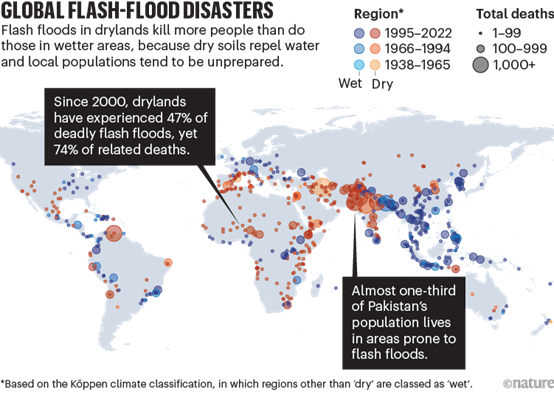为何全球最干旱地区频遭洪涝灾害破坏?
Flash floods: why are more of them devastating the world's driest regions?
作者:Jie Yin, Yao Gao, Ruishan Chen, Dapeng Yu, Robert Wilby, Nigel Wright, Yong Ge, Jeremy Bricker, Huili Gong & Mingfu Guan
期刊:Nature
In 2022, around two-thirds of Pakistan was affected by widespread flash flooding, with more than 1,500 people killed and around 33 million made homeless. Almost 2,000 people died in flash floods across Africa, and parts of the United Arab Emirates, Iran, Saudi Arabia, Qatar, Oman and Yemen were inundated with water. On August 18th, a flash flood in Datong town in Qinghai province, China, washed away more than 1,500 homes and killed dozens of people in less than one hour.
Flash floods are a growing threat in the world’s arid or semi-arid regions, causing heavy casualties and economic losses. Our analysis using the Emergency Events Database (EM-DAT; www.emdat.be) shows that, since 2000, such regions experienced less than half (47%) of deadly flash floods globally, yet saw almost three-quarters (74%) of related deaths (see ‘Global flash-flood disasters’). The majority of these floods (87%) and associated deaths (97%) occurred in low- and middle-income countries.
The increased impact of climate change and human activities is making such events more intense and frequent. Climate change has led to a significant “warming-wetting” trend in the arid and semi-arid regions worldwide, with the 5-day maximum level of rainfall about 8% higher in the 2010s than in the 1980s. In parts of Pakistan, the 5-day maximum level of rainfall is 75% greater today than it was before 1900 (see go.nature.com/41awzzj). By our calculation, more people are living in drylands, and cities in such areas are expanding rapidly. Yet only 1% of those people are living in developed countries. And the proportion of the world’s land area classed as arid or semi-arid is projected to increase as the world warms.
Researchers, practitioners and policymakers need to model, assess and mitigate the risk of flash flooding in drylands in a changing environment. Here, we set out six research priorities for doing so.

Source: EM-DAT, CRED/UC Louvain (www.emdat.be); Analysis by J. Yin et al.
2022年,巴基斯坦发生严重洪涝灾害,造成全国三分之二区域被淹,超过1500人死亡、3300万人无家可归。非洲部分地区因洪灾导致超过2000人死亡,地处中东的阿联酋、沙特、伊朗、卡塔尔、阿曼、也门等国的部分区域(甚至沙漠地区)也不同程度地发生暴雨洪涝灾害。我国青海省大通县发生的“8.18”山洪灾害,暴雨在不到一小时内形成山洪泥石流,造成数十人死亡,超过1500栋房屋受损。
根据EM-DAT数据分析显示:全球干旱半干旱地区暴雨洪涝灾害呈现快速上升的趋势,造成了极为严重的人员伤亡和经济损失。尤其是2000年以来,全球不到半数(约47%)的暴雨山洪致死事件发生在干旱半干旱地区,却造成了全球近四分之三(74%)的因灾死亡。绝大多数的暴雨山洪灾害事件(87%)及因灾死亡人数(97%)发生在中低收入国家和地区。
气候变化和人类活动影响加剧,是导致全球干旱半干旱地区极端暴雨山洪灾害日益频发的主要因素。气候变化导致全球干旱半干旱地区暖湿化趋势显著,2010年代5日最大降水较1980年代上升了约8%。巴基斯坦5日最大降水则较1900年提高了75%。此外,全球干旱半干旱地区面积、人口数量和城市化水平也在不断上升,但仅有约1%的人口分布于发达国家。
在此背景下,亟需决策者、研究者以及相关从业人员针对以下几个方面开展建模、评估以及减缓等措施以应对未来可能出现的极端灾害风险。
(实习生江薇编译)








